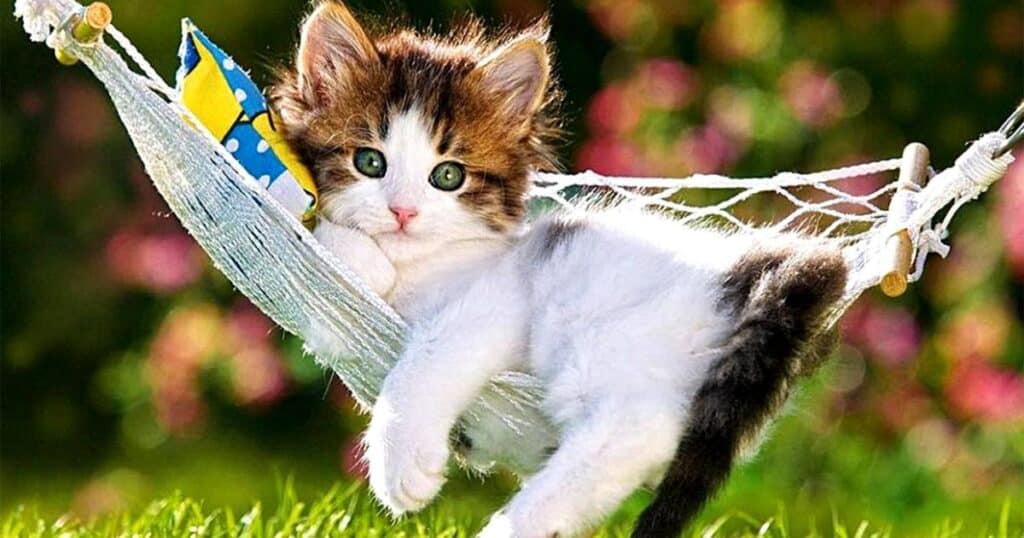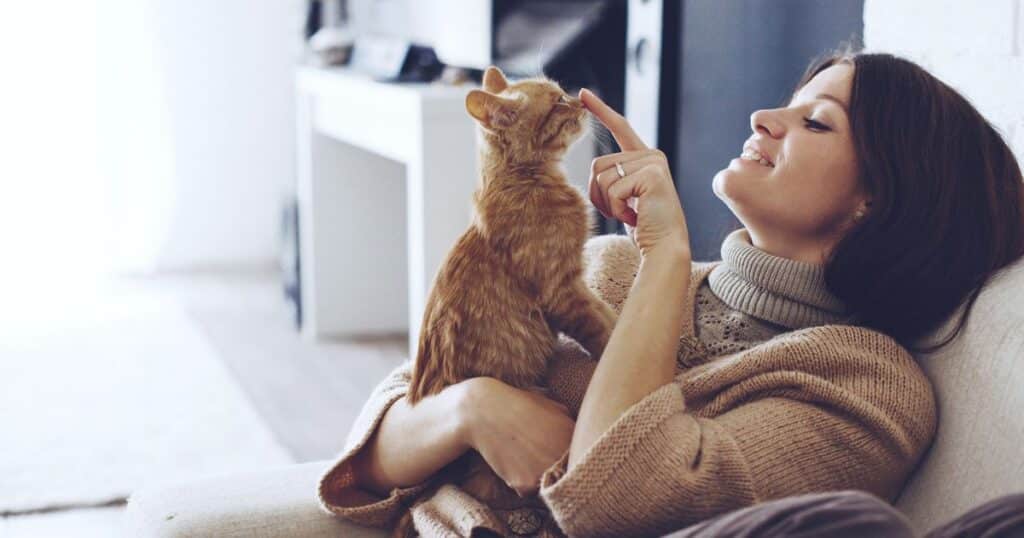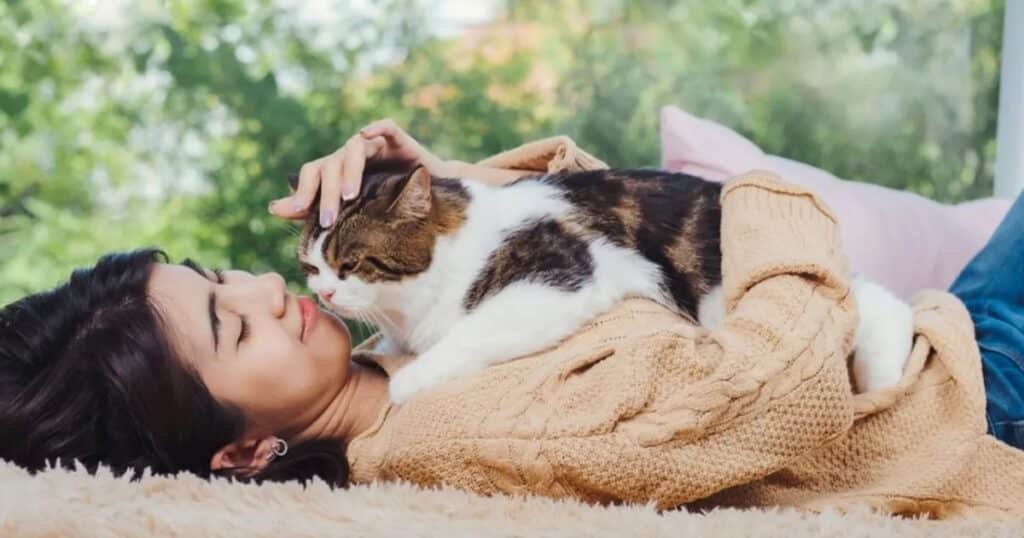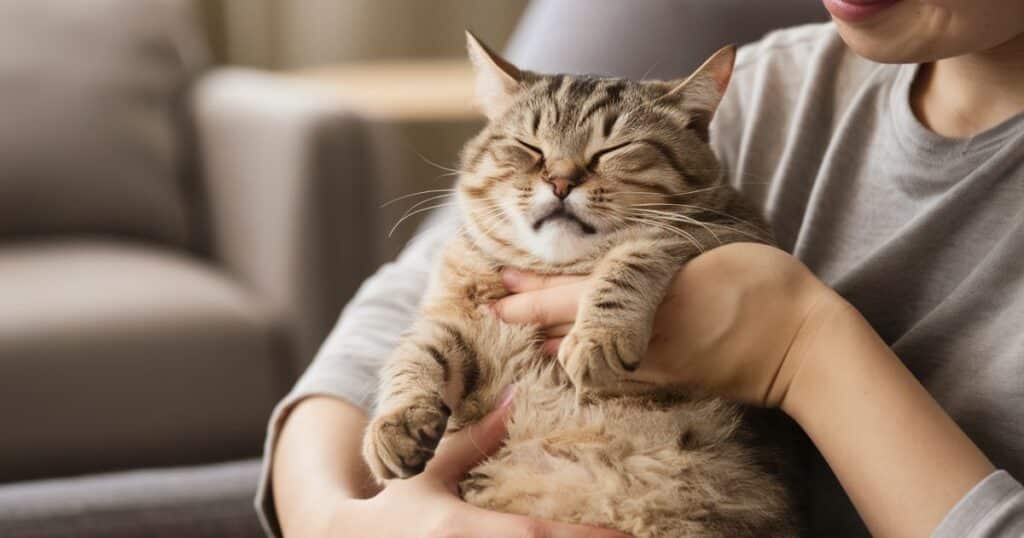Have you ever found yourself cradling your furry friend like a newborn, only to realize they’re purring contentedly in your arms? You’re not alone. Many cat owners are surprised to discover their feline companions enjoy being held like babies. This peculiar behavior has puzzled and delighted pet parents for years.
In this comprehensive guide, we’ll dive deep into the reasons behind this endearing trait, explore why some cats might not enjoy it, and learn the proper techniques for holding your cat in this special way.
Key Takeaways
Before we delve into the nitty-gritty, let’s highlight the essential points we’ll cover:
- Cats often enjoy being cradled due to comfort, safety, and bonding instincts
- Not all cats like this position – respecting their preferences is crucial
- Proper holding techniques can enhance your cat’s enjoyment
- Understanding feline body language is key to a happy cuddle session
- Cat cuddling preferences can vary based on individual personality and experiences
- The roots of this behavior often trace back to kitten behavior
- Building cat trust is essential for a positive holding experience
- Feline comfort is the ultimate goal in any interaction with your cat
The Purrfect Embrace: Why Cats Like To Be Held Like A Baby
Snuggled Up in Safety: Seeking Comfort and Security
When you cradle your cat like a baby, you’re providing them with a cozy cocoon of safety. This position mimics the protective embrace of a mother cat, tapping into deep-seated instincts of comfort and security. For many cats, being held this way is the ultimate display of trust in their human companion.
Consider the world from your cat’s perspective. They’re surrounded by giants (that’s us humans) and potential threats. By allowing themselves to be held in such a vulnerable position, they’re demonstrating an incredible level of cat trust in you. It’s a testament to the bond you’ve built together.
The warmth of your body, the sound of your heartbeat, and the gentle pressure of being cradled can all contribute to a sense of feline comfort. In a way, you’re recreating the safe, nurturing environment they experienced as kittens – a time when they were completely dependent on their mother for protection and care.
This desire for comfort and security isn’t just a quirk of domestication. Wild cats, particularly young ones, also seek out cozy, enclosed spaces for rest and safety. Your arms, when cradling your cat, create a similar environment a mobile safe haven where they can relax and let their guard down.
Moreover, the elevated position of being held can satisfy a cat’s natural instinct to seek high perches. In the wild, height equals safety, allowing cats to survey their surroundings and stay out of reach of potential predators. When you lift your cat into your arms, you’re inadvertently indulging this instinct, adding another layer of security to the experience.
Kitten Flashbacks: Instinctual Behavior from Infancy

Speaking of kittens, let’s explore how early experiences shape adult cat behavior. When kittens are born, they’re helpless and rely entirely on their mother. During their first few weeks of life, they spend a significant amount of time being carried and cradled by their mom.
This early kitten behavior creates positive associations with being held. The sensation of being cradled becomes linked with feelings of safety, nourishment, and love. For some cats, these associations persist into adulthood, leading them to seek out similar experiences with their human caregivers.
Here’s a breakdown of how kitten behavior develops and influences adult preferences:
- Newborn to 2 weeks: Kittens are completely dependent on their mother, spending most of their time nursing and being carried.
- 2 to 4 weeks: Kittens start exploring but still return to mom for comfort and carrying.
- 4 to 8 weeks: Independence grows, but positive associations with being held are solidified.
- 8 weeks and beyond: Some kittens retain their love for being cradled, while others become more independent.
It’s important to note that not all adult cats will retain this kitten-like desire for cradling. Just like humans, cats have individual personalities and preferences that develop over time.
The critical period for socialization in kittens occurs between 2 and 7 weeks of age. During this time, positive experiences with handling and human interaction can shape a cat’s lifelong attitudes towards being held and cuddled. Kittens who receive gentle, consistent handling during this period are more likely to enjoy close physical contact as adults.
Interestingly, the way a mother cat carries her kittens, supporting their whole body with a gentle but firm grip. is remarkably similar to how we hold cats “like babies.” This similarity may explain why some cats find this position so comforting, even as adults. It triggers a deep, instinctual memory of maternal care and protection.
MORE POST: Why Does My Cat Trill And Run Away?
Purring for Love: Bonding with Their Owners
When your cat allows you to hold them like a baby, it’s not just about recreating kitten memories – it’s also a powerful bonding experience. Cat cuddling in this intimate way triggers the release of oxytocin, often called the “love hormone,” in both you and your feline friend.
Oxytocin is the same hormone that strengthens the bond between human parents and their babies. It promotes feelings of trust, relaxation, and affection. By engaging in this close physical contact, you’re essentially reinforcing your emotional connection with your cat.
The similarities between human-cat and parent-child interactions are striking:
| Human-Baby Interaction | Human-Cat Interaction |
| Cradling for comfort | Holding cat like a baby |
| Gentle rocking motion | Swaying while holding |
| Soft, soothing voice | Speaking in “cat voice” |
| Skin-to-skin contact | Petting and stroking |
| Eye contact and smiling | Slow blinking exchanges |
These parallels highlight why being held like a baby can be such a profound sign of affection from your cat. They’re not just tolerating the position; they’re actively participating in a bonding ritual that strengthens your relationship.
The release of oxytocin during these cuddle sessions has benefits for both you and your cat. For cats, it can lower stress levels, reduce anxiety, and even boost their immune system. For humans, interacting with pets in this way has been shown to lower blood pressure, reduce the risk of heart disease, and alleviate symptoms of depression and anxiety.
Moreover, the act of holding your cat like a baby often involves direct eye contact. In the feline world, prolonged eye contact can be threatening, but slow blinking is a sign of trust and affection. When you and your cat engage in this “slow blink” exchange during cuddle time, you’re essentially saying “I love you” in cat language.
When Cuddles Aren’t Cute: Possible Reasons for Cats Not Liking To Be Held
While many cats enjoy being cradled, it’s essential to recognize that not all felines share this preference. Understanding the reasons behind a cat’s dislike for being held can help you respect their boundaries and find alternative ways to show affection.
Scaredy Cats: Past Traumatic Experiences
Unfortunately, some cats may have negative associations with being held due to past trauma. Rough handling, neglect, or frightening experiences during their formative weeks can leave lasting impressions on a cat’s psyche. For these cats, being picked up or cradled might trigger feelings of fear or anxiety.
Rebuilding cat trust with a wary feline takes patience and understanding. Here are some tips:
- Let the cat approach you on their terms
- Use positive reinforcement with treats and praise
- Start with brief, gentle touches before attempting to pick them up
- Never force a cat to be held if they’re showing signs of distress
Remember, every cat has a unique history. By respecting their boundaries and working at their pace, you can help them overcome past traumas and potentially develop a more positive attitude towards being held.
Cats who have been rescued from abusive or neglectful situations may be particularly averse to being held. In these cases, the process of building trust can take months or even years. It’s crucial to create a safe, predictable environment for these cats and to allow them to set the pace for physical interaction.
Ouch! Physical Discomfort or Pain
Sometimes, a cat’s aversion to being held like a baby isn’t psychological – it’s physical. Various medical conditions can make this position uncomfortable or even painful for your feline friend. These might include:
- Arthritis or joint pain
- Digestive issues
- Respiratory problems
- Recent injuries or surgeries
- Obesity, which can put strain on their body
Regular veterinary check-ups are crucial for identifying and addressing any underlying health issues that might be affecting your cat’s comfort levels. If your once cuddly cat suddenly becomes averse to being held, it could be a sign that something’s not right health-wise.
For senior cats or those with known medical issues, you may need to adapt your holding technique. Supporting their body more fully or avoiding pressure on sensitive areas can make the experience more enjoyable for them.
Arthritis, in particular, is a common issue in older cats that can make being held uncomfortable. The baby-holding position might put pressure on sore joints or require the cat to bend in ways that cause discomfort. In these cases, a more supportive hold that keeps the cat’s body straight may be more tolerable.
Obesity is another factor that can make being held unpleasant for cats. Excess weight puts strain on their joints and can make it harder for them to breathe comfortably when held against your body. If your cat is overweight, working with your vet on a diet and exercise plan can improve their overall health and potentially make them more amenable to cuddles.
Born to Be Wild: Instinctive Behaviors
It’s important to remember that despite thousands of years of domestication, cats still retain many of their wild instincts. Some cats have a strong natural inclination towards independence and may prefer to keep all four paws on the ground.
Breed and personality play significant roles in a cat’s cuddling preferences. For example:
- Siamese and Burmese cats are often more people-oriented and may enjoy being held.
- Maine Coons, despite their size, are often called “gentle giants” and may tolerate cradling.
- More aloof breeds like Russian Blues or Persians might prefer less hands-on affection.
However, these are generalizations, and individual cats within a breed can have vastly different preferences. The key is to accept and love your cat for their unique temperament, finding ways to bond that suit their personality.
The instinct for independence is deeply ingrained in feline DNA. In the wild, adult cats are solitary hunters who don’t rely on others for survival (except during kittenhood and mating). This self-reliance can translate into a preference for more “hands-off” affection in some domestic cats.
Mastering the Art: How To Properly Hold Your Cat Like A Baby

If your cat does enjoy being cradled, learning the proper technique can enhance their enjoyment and strengthen your bond. Cat holding is an art form that requires patience, gentleness, and an understanding of feline body language.
Gentle Giants: Cradling Them with Support
The perfect baby-hold technique for your cat involves providing them with a sense of security without feeling restrained. Here’s a step-by-step guide:
- Approach your cat calmly when they’re relaxed.
- Scoop them up gently, supporting their hindquarters with one arm.
- Use your other arm to support their front legs and chest.
- Cradle them against your body, allowing their head to rest in the crook of your elbow.
- Adjust your hold to ensure their spine is straight and they’re not twisted.
The key is to provide support for their entire body, especially their head and hindquarters. This mimics the way a mother cat would carry her kittens, creating a sense of feline comfort and security.
When picking up your cat, move slowly and confidently. Hesitant or jerky movements can make your cat feel insecure. As you lift, keep their body close to yours to provide a sense of stability. Some cats prefer to have their back feet resting on something, so you might find that supporting their hind end with your forearm while they push their back paws against your body works well.
Freedom to Flee: Avoiding Restraining Them
While it might be tempting to hold your cat tightly, especially if you’re worried about them jumping down, it’s crucial to avoid making them feel trapped. Allowing an easy escape route builds cat trust and makes the experience more enjoyable for them.
Forcing a cat to be held when they’re uncomfortable can have negative consequences:
- It may damage the trust between you and your cat
- The cat may develop a fear of being picked up
- They might resort to scratching or biting to get away
If your cat doesn’t enjoy being cradled, there are plenty of alternative ways to show affection:
- Gentle petting while they’re on their favorite perch
- Interactive playtime with toys
- Sitting near them and talking softly
- Offering treats and praise for positive interactions
Remember, respecting your cat’s preferences is key to maintaining a loving, trusting relationship.
When holding your cat, always be prepared to let them go if they indicate they want down. Signs that your cat wants to end the cuddle session include:
- Tensing of their body
- Tail swishing or thumping
- Ears flattening or rotating backwards
- Shifting their weight as if preparing to jump
If you notice these signs, start lowering your cat towards the ground. Many cats appreciate being set down gently rather than simply released. This controlled descent helps them feel secure and in control of the situation.
Reading the Room: Paying Attention to Their Body Language
Cats communicate primarily through body language, and learning to read these signals is crucial for successful cat cuddling. Here are some signs that your cat is enjoying being held like a baby:
- Purring
- Relaxed body posture
- Slow blinking or half-closed eyes
- Kneading with their paws
- Rubbing their head against you
Conversely, watch out for these warning signals that your cat wants to be put down:
- Tail twitching or lashing
- Ears flattened or turned back
- Growling or hissing
- Squirming or pushing away
- Dilated pupils
By paying close attention to these cues, you can ensure that cat holding remains a positive experience for both of you. Over time, you may be able to gradually increase the duration of cuddle sessions through positive reinforcement.
It’s worth noting that some cats may exhibit a mixture of positive and negative signals. For example, a cat might purr while also having a slightly twitchy tail. In these cases, it’s best to err on the side of caution and give your cat a break from being held.
The position of your cat’s whiskers can also provide clues about their comfort level. Forward-facing whiskers generally indicate a happy, curious cat, while whiskers pulled back against the face may signal discomfort or anxiety.
Pay attention to your cat’s breathing as well. Rapid or shallow breathing can be a sign of stress, even if the cat isn’t showing other obvious signs of discomfort. A relaxed cat being held will typically have slow, steady breaths.
Some cats may also use vocalizations to communicate their feelings about being held. While purring is generally a good sign, be aware that cats sometimes purr when they’re anxious as a self-soothing mechanism. Soft chirps or trills often indicate happiness, while low growls or hisses are clear signs of displeasure.
The Art of the Gradual Introduction
For cats who are unsure about being held like babies, a gradual introduction to the experience can work wonders. Here’s a step-by-step approach:
- Start by petting your cat in their favorite spots while they’re on a surface they feel safe on, like a cat tree or your lap.
- Once they’re comfortable with petting, try brief lift-and-hold sessions. Lift your cat a few inches off the surface for just a second or two, then set them back down and reward with treats or praise.
- Gradually increase the duration of these lift-and-hold sessions, always watching for signs of discomfort.
- When your cat seems comfortable being lifted, start to cradle them against your body for short periods. Again, reward with treats and praise.
- Slowly extend the duration of the cradling sessions, always letting your cat set the pace.
- If at any point your cat shows signs of stress, go back a step in the process and proceed more slowly.
This method allows your cat to build positive associations with being held gradually, increasing their comfort and trust over time.
The Role of Early Socialization
The experiences a kitten has in their early weeks of life can significantly impact their attitude towards being held as an adult. Kittens who are gently handled by humans from a young age (around 2-7 weeks old) are more likely to enjoy close physical contact as adults.
If you’re adopting a kitten, ask the shelter or breeder about their socialization practices. Kittens who have been regularly handled, cuddled, and exposed to different people are more likely to grow into cuddle-loving adults.
For those with adult cats who aren’t fans of being held, don’t despair. While early socialization is important, it’s not the only factor. With patience, positive reinforcement, and respect for your cat’s boundaries, you can still build a strong, affectionate bond – it just might not involve being held like a baby.
The Health Benefits of Cat Cuddling

The act of holding your cat like a baby isn’t just enjoyable – it can also have tangible health benefits for both you and your feline friend.
Benefits for Cats
- Stress Reduction: Physical contact with a trusted human can lower a cat’s stress levels, reducing the production of cortisol (the stress hormone) and promoting relaxation.
- Pain Relief: The act of purring, which often accompanies cuddling, has been shown to have healing properties. The vibrations produced by purring can help heal bones and soft tissue, reduce swelling, and provide pain relief.
- Bonding and Security: Regular, positive physical contact reinforces the bond between cat and owner, making the cat feel more secure in their environment.
- Mental Stimulation: Interaction with their human provides mental stimulation for cats, which is crucial for their overall well-being and can help prevent behavioral issues.
Benefits for Humans
- Stress Relief: Petting and holding a cat has been shown to lower blood pressure and reduce stress in humans.
- Improved Mood: Interacting with pets, including cats, can boost levels of serotonin and dopamine, the “feel-good” neurotransmitters in our brains.
- Companionship: For many people, the close physical contact involved in holding a cat provides a sense of companionship and emotional support.
- Heart Health: Cat owners have been found to have a lower risk of cardiovascular diseases, possibly due to the stress-reducing effects of pet ownership.
- Improved Immune Function: Some studies suggest that exposure to pets from a young age can strengthen the human immune system.
Wrapping Up the Purrito: Conclusion
In conclusion, the endearing behavior of cats enjoying being held like babies is a complex interplay of instinct, early experiences, and the unique bond between felines and their human companions. While many cats find comfort and security in this position, it’s essential to remember that each cat is an individual with their own preferences.
Understanding the reasons behind this behavior – from the echoes of kittenhood to the powerful bonding hormones released during close contact – can deepen our appreciation for these special moments. At the same time, recognizing why some cats might not enjoy being cradled helps us respect their boundaries and find alternative ways to show our love.
By mastering the art of proper cat holding, paying attention to feline body language, and always prioritizing our cats’ comfort, we can create positive experiences that strengthen the human-cat bond. Whether your feline friend is a cuddle bug or prefers their affection from a distance, the key is to cherish and respect their unique personality.
Remember, the goal of any interaction with your cat should be to enhance their feline comfort and build cat trust. By doing so, you’ll nurture a relationship filled with mutual understanding, respect, and plenty of purrs.
Ultimately, the joy of holding your cat like a baby isn’t just about the physical act – it’s about the trust, love, and connection it represents. It’s a testament to the special relationship we’ve cultivated with these independent, yet affectionate creatures. So the next time your cat settles contentedly into your arms, take a moment to appreciate the remarkable bond you share.
ALSO READ THIS POST: Why Does My Cat Lick Me Then Bite Me? Exploring This Puzzling Feline Behavior
FAQs: Your Burning Questions About Cat Cuddling
Is it okay to hold my cat like a baby if they seem to enjoy it?
Absolutely! If your cat shows signs of contentment and relaxation when held this way, it’s a wonderful bonding experience for both of you. Just be sure to pay attention to their body language and respect their limits.
At what age do kittens typically outgrow wanting to be held this way?
There’s no set age, as it varies greatly between individuals. Some cats retain their love for being cradled well into adulthood, while others may become more independent as early as 3-4 months old.
Can I train my adult cat to like being cradled?
While you can’t force a cat to enjoy a particular type of handling, you can use positive reinforcement to create more positive associations. Start with short sessions, lots of treats, and always respect your cat’s boundaries.
Are certain cat breeds more likely to enjoy being held like babies?
Some breeds, like Ragdolls and Siamese, are known for being more affectionate and tolerant of handling. However, individual personality plays a much bigger role than breed in determining a cat’s cuddling preferences.
How long is it safe to hold my cat in this position?
There’s no strict time limit, but it’s best to follow your cat’s cues. Some cats may enjoy lengthy cuddle sessions, while others prefer brief interactions. Always allow them to leave when they want to, and avoid holding them in ways that could strain their body.
My cat used to enjoy being held but now seems uncomfortable. What could be causing this?
Changes in a cat’s tolerance for being held can be due to various factors, including age-related discomfort, illness, stress, or changes in their environment. If this change is sudden or accompanied by other behavioral changes, it’s best to consult with your veterinarian.
Is it normal for my cat to knead or “make biscuits” when I hold them like a baby?
Yes, this is a common behavior that often indicates contentment. Kneading is a behavior kittens display when nursing, and adult cats often continue this behavior when they’re feeling relaxed and happy.
My cat likes to be held, but not like a baby. Is this normal?
Absolutely! Every cat has their own preferences for how they like to be held and shown affection. Some cats prefer to be held upright against your chest, while others might enjoy draping themselves over your shoulder. The key is to find what your individual cat enjoys.
Can holding my cat like a baby help with socialization?
For kittens and cats who are still learning to trust humans, gentle handling, including holding them like babies (if they tolerate it), can be a great socialization tool. However, it’s crucial to introduce this gradually and always respect the cat’s comfort level.
Is it safe to hold a pregnant cat like a baby?
While many pregnant cats enjoy affection, it’s best to be extra gentle and cautious. As the pregnancy progresses, the abdomen becomes more sensitive, and the added weight can make certain positions uncomfortable. Always consult with your vet for the best way to handle a pregnant cat.

Davin Connor is an experienced author with 3 years in pets writing. Known for concise, informative content, he shares expertise on pet care, behavior, and health through his engaging articles.






